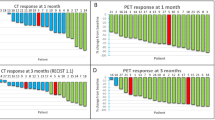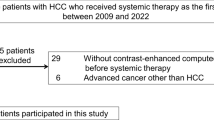Abstract
Purpose
To evaluate safety in an interim analysis of transarterial chemoembolization (TACE) with doxorubicin-eluting beads (DEB) in 13 patients with hepatic metastases from neuroendocrine tumors (NETs) as part of a phase II trial.
Methods
Institutional Review Board approval and informed consent were obtained. Thirteen patients completed preliminary safety analysis. Their mean age was 65 years, Eastern Cooperative Oncology Group status was 0/1, tumor burden range was 4–75 %, and mean targeted tumor size was 5.9 cm. Up to four DEB-TACE sessions (100–300 μm beads loaded with ≤100 mg doxorubicin) within 6 months were allowed. Tumor response was assessed by magnetic resonance imaging 1 month after treatment using contrast-enhancement [European Association for the Study of the Liver (EASL) and size Response Evaluation Criteria in Solid Tumors (RECIST)] criteria. Safety was assessed by National Cancer Institute Common Terminology Criteria.
Results:
DEB-TACE was successfully performed in all 13 patients. At 1 month follow-up, there was a mean 12 % decrease in tumor size (p < 0.0003) and a 56 % decrease in tumor enhancement (p < 0.0001). By EASL criteria, the targeted lesion objective response rate was 78 %. Grade 3 to 4 toxicities were fatigue (23 %), increased alanine amino transferase (15 %), hyperglycemia (15 %), and abdominal pain (8 %). Seven patients developed bilomas (54 %); all of these patients had multiple small (<4 cm) lesions. Subsequently, four underwent percutaneous drainage, three for abscess formation and one for symptoms related to mass effect.
Conclusions
Although biloma and liver abscess are known risks after TACE, the high incidence in our study population was unexpected and forced interruption of the trial. Although this occurred in a small group of patients, we have changed our technique and patient selection as a result of these findings, thus allowing resumption of the trial.



Similar content being viewed by others
References
Modlin IM, Lye KD, Kidd M (2003) A 5-decade analysis of 13,715 carcinoid tumors. Cancer 97(4):934–959
Kress O, Wagner HJ, Wied M, Klose KJ, Arnold R, Alfke H (2003) Transarterial chemoembolization of advanced liver metastases of neuroendocrine tumors—a retrospective single-center analysis. Digestion 68(2–3):94–101
Moertel CG (1983) Treatment of the carcinoid tumor and the malignant carcinoid syndrome. J Clin Oncol 1(11):727–740
Saltz L et al (1994) A phase II trial of alpha-interferon and 5-fluorouracil in patients with advanced carcinoid and islet cell tumors. Cancer 74(3):958–961
Schnirer I, Yao JC, Ajani JA (2003) Carcinoid—a comprehensive review. Acta Oncol 42(7):672–692
Mayo SC, de Jong MC, Pawlik TM (2011) Surgical management and emerging therapies to prolong survival in metastatic neuroendocrine cancer. Ann Surg Oncol 18(53):S220–221
Gupta S et al (2005) Hepatic arterial embolization and chemoembolization for the treatment of patients with metastatic neuroendocrine tumors: variables affecting response rates and survival. Cancer 104(8):1590–1602
Touzios JG et al (2005) Neuroendocrine hepatic metastases: does aggressive management improve survival? Ann Surg 241(5):776–783 discussion 783–785
Ruutiainen AT et al (2007) Chemoembolization and bland embolization of neuroendocrine tumor metastases to the liver. J Vasc Interv Radiol 18(7):847–855
Vogl TJ et al (2009) Liver metastases of neuroendocrine tumors: treatment with hepatic transarterial chemotherapy using two therapeutic protocols. AJR Am J Roentgenol 193(4):941–947
Mayo SC et al (2011) Surgery versus intra-arterial therapy for neuroendocrine liver metastasis: a multicenter international analysis. Ann Surg Oncol 18(13):3657–3665
de Baere T et al (2008) Transarterial chemoembolization of liver metastases from well differentiated gastroenteropancreatic endocrine tumors with doxorubicin-eluting beads: preliminary results. J Vasc Interv Radiol 19(6):855–861
Gaur SK et al (2011) Hepatic arterial chemoembolization using drug-eluting beads in gastrointestinal neuroendocrine tumor metastatic to the liver. Cardiovasc Intervent Radiol 34(3):566–572
El-Serag HB et al (2003) The continuing increase in the incidence of hepatocellular carcinoma in the United States: an update. Ann Intern Med 139(10):817–823
Davila JA et al (2004) Hepatitis C infection and the increasing incidence of hepatocellular carcinoma: a population-based study. Gastroenterology 127(5):1372–1380
Parkin DM et al (2005) Global cancer statistics, 2002. CA Cancer J Clin 55(2):74–108
Bosch FX et al (2005) Epidemiology of hepatocellular carcinoma. Clin Liver Dis 9(2):191–211 v
Srivatanakul P, Sriplung H, Deerasamee S (2004) Epidemiology of liver cancer: an overview. Asian Pac J Cancer Prev 5(2):118–125
Ahmed F et al (2008) National trends and disparities in the incidence of hepatocellular carcinoma, 1998–2003. Prev Chronic Dis 5(3):A74
Jemal A et al (2008) Cancer statistics, 2008. CA Cancer J Clin 58(2):71–96
Reuter NP et al (2009) Radiofrequency ablation vs. resection for hepatic colorectal metastasis: therapeutically equivalent? J Gastrointest Surg 13(3):486–491
Reyes DK et al (2009) Single-center phase II trial of transarterial chemoembolization with drug-eluting beads for patients with unresectable hepatocellular carcinoma: initial experience in the United States. Cancer J 15(6):526–532
Therasse P et al (2000) New guidelines to evaluate the response to treatment in solid tumors. European Organization for Research and Treatment of Cancer, National Cancer Institute of the United States, National Cancer Institute of Canada. J Natl Cancer Inst 92(3):205–216
Bruix J, Sherman M (2005) Management of hepatocellular carcinoma. Hepatology 42(5):1208–1236
Kamel IR et al (2009) Unresectable hepatocellular carcinoma: serial early vascular and cellular changes after transarterial chemoembolization as detected with MR imaging. Radiology 250(2):466–473
Gasnier A et al. (2010) In: IEEE international symposium on biomedical imaging: from nano to macro, Austin, TX, USA, 13–18 June 2010
Mory B et al. (2009) Non-Euclidean image-adaptive radial basis functions for 3D interactive segmentation. In: Twelfth IEEE international conference on computer vision (ICCV), Kyoto, Japan
Miyayama S et al (2010) Main bile duct stricture occurring after transcatheter arterial chemoembolization for hepatocellular carcinoma. Cardiovasc Intervent Radiol 33(6):1168–1179
Kim HK et al (2001) Ischemic bile duct injury as a serious complication after transarterial chemoembolization in patients with hepatocellular carcinoma. J Clin Gastroenterol 32(5):423–427
Sakamoto I et al (2003) Intrahepatic biloma formation (bile duct necrosis) after transcatheter arterial chemoembolization. AJR Am J Roentgenol 181(1):79–87
Yu JS et al (2002) Predisposing factors of bile duct injury after transcatheter arterial chemoembolization (TACE) for hepatic malignancy. Cardiovasc Intervent Radiol 25(4):270–274
Liapi E, Geschwind JF (2007) Transcatheter and ablative therapeutic approaches for solid malignancies. J Clin Oncol 25(8):978–986
Liapi E, Geschwind JF (2010) Intra-arterial therapies for hepatocellular carcinoma: where do we stand? Ann Surg Oncol 17(5):1234–1246
Lammer J et al (2010) Prospective randomized study of doxorubicin-eluting-bead embolization in the treatment of hepatocellular carcinoma: results of the PRECISION V study. Cardiovasc Intervent Radiol 33(1):41–52
Malagari K et al (2008) Transarterial chemoembolization of unresectable hepatocellular carcinoma with drug eluting beads: results of an open-label study of 62 patients. Cardiovasc Intervent Radiol 31(2):269–280
Malagari K et al (2010) Prospective randomized comparison of chemoembolization with doxorubicin-eluting beads and bland embolization with BeadBlock for hepatocellular carcinoma. Cardiovasc Intervent Radiol 33(3):541–551
Varela M et al (2007) Chemoembolization of hepatocellular carcinoma with drug eluting beads: efficacy and doxorubicin pharmacokinetics. J Hepatol 46(3):474–481
Lencioni R et al. (2011) Transcatheter treatment of hepatocellular carcinoma with doxorubicin-loaded DC Bead (DEBDOX): technical recommendations. Cardiovasc Intervent Radiol, October 2011. [Epub ahead of print]
Geschwind JF et al (2002) Influence of a new prophylactic antibiotic therapy on the incidence of liver abscesses after chemoembolization treatment of liver tumors. J Vasc Interv Radiol 13(11):1163–1166
De Jong MC et al (2010) Liver-directed therapy for hepatic metastases in patients undergoing pancreaticoduodenectomy: a dual-center analysis. Ann Surg 252(1):142–148
Guiu B et al (2012) Liver/biliary injuries following chemoembolisation of endocrine tumours and hepatocellular carcinoma: lipiodol vs. drug-eluting beads. J Hepatol 56(3):609–617
Acknowledgments
This study was partially funded by National Institutes of Health Grant No. R01 CA160771-2 and BioCompatibles UK Ltd. Clinical Trials.gov trial no. NCT00730483. Previous presentations include the following: (1) American Society of Clinical Oncology, Gastrointestinal Cancers Symposium, San Francisco, CA, January 20 to 22, 2011; (2) Cardiovascular and Interventional Radiological Society of Europe, 2011, Sept 10–14, and (3) Society of Interventional Radiology, 36th Annual Scientific Meeting, Chicago, IL, 2011.
Conflict of interest
Nikhil Bhagat, Mingde Lin, and Jean-Francois Geschwind were partially funded by National Institutes of Health Grant No. R01 CA 160771-2. Jean-Francois Geschwind was partially funded by Biocompatibles UK Ltd.
Author information
Authors and Affiliations
Corresponding author
Rights and permissions
About this article
Cite this article
Bhagat, N., Reyes, D.K., Lin, M. et al. Phase II Study of Chemoembolization With Drug-Eluting Beads in Patients With Hepatic Neuroendocrine Metastases: High Incidence of Biliary Injury. Cardiovasc Intervent Radiol 36, 449–459 (2013). https://doi.org/10.1007/s00270-012-0424-y
Received:
Accepted:
Published:
Issue Date:
DOI: https://doi.org/10.1007/s00270-012-0424-y




